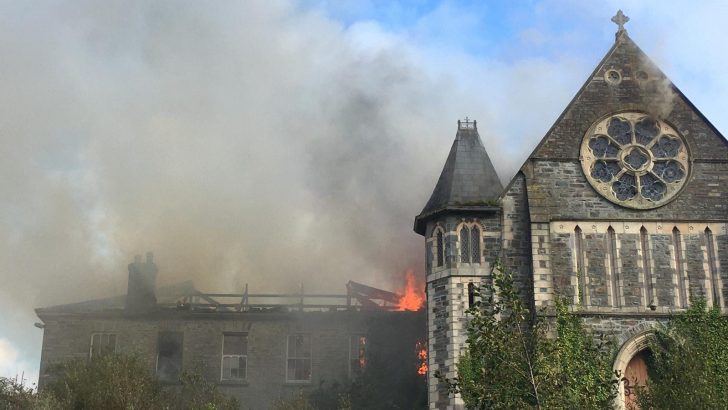Skibbereen convent fire is a tragic reminder of what we have to lose, writes Ruadhán Jones
After the penal laws were lifted in the early 19th Century, there was an explosion in the number of convents being built in Ireland. So many were built, that they became a common sight across the country, and to this day many towns in Ireland will have an old convent building as a centrepiece of the landscape.
But familiarity breeds contempt – their ubiquity means that they have long been neglected, both by historians and conservationists, according to architectural historian and consultant Jessie Castle. She is conducting research into the social and architectural history of Irish convents, in conjunction with Irish historian Gillian O’Brien, and has extensive experience in conservation projects through her work with JCA Architects in Cork.
“They are very often protected structures, and they are included in their local authorities list of protected structures,” she explains. “With that, there’s an onus on the owner to maintain those buildings and to protect them from deterioration, but unfortunately as we all know that’s not enforced very often.”
Reminder
The Skibbereen convent, which formerly housed nuns from the Sisters of Mercy, serves as a reminder of what we have to lose, says Ms Castle.
“As we lose each one of these, it’s getting more important that we make the effort to preserve them because you know, it’s easy to say they’re all over the place, there’s nothing unique about them and then suddenly there are very few of them left. The sad thing about Skibbereen is that there appears to have been a very extensive plan and design to redevelop that building.
“For me, the loss of that sort of architecture is very sad, I do feel those types of buildings are worthy of protection.
“There seems to be quite a positive association in the town with the schools and the whole history of the convent. A lot of people would have been involved with the schools and convent one way or another, it seems to be felt as quite a loss by people who live in the town there.”
***
For Ms Castle, the lack of attention to convents and their architecture does a disservice to their importance in the history of the local communities, as well as overlooking the beauty and distinctiveness of their architecture.
In the case of the Skibbereen chapel, for example, it was designed by architects E.W. Pugin and G.C. Ashlin, two of the foremost architects working in Ireland at the time of its construction in the 1860s.
“That chapel I know had been altered and its original decorative scheme covered over,” Ms Castle explains, “but it was actually part of the planning works that these modern works would be removed to see if there was any of the historic decorative design left.
“If you look at historic photographs and drawings for that chapel, it really was a beautiful example of craftmanship and if you think of the hours that were spent and the training behind it and the towns people involved. I know there are other examples around, but they are becoming more rare.”
Research
Some convent buildings can be traced back 200-300 years, preceding the emancipation of Catholics in Ireland. In the course of her research, Ms Castle discovered that “women were quite involved in the design of these convents, quite an unexpected find, and not something that has been frequently recorded.
“There’s Wexford, which was an early convent, and that seems to have been purpose built,” Ms Castle says. “It has a very beautiful chapel which was designed by one of the sisters there – she designed and supervised the construction of the chapel. We know that Nano Nagel supervised the construction of the South Presentation convent (in Cork) herself. She was on site and she was checking the work, specifying what was to be done there.”
Ms Castle also stresses that social impact of the convents has been overlooked historically. Many of them, especially those of the Presentation Sisters, were associated with the building of schools, and the they were integral to the economies of many rural towns.
There is an urgency there to try and see these buildings while they’re still in use as convents, because once they’re not things change very quickly…access is often impossible and unfortunately they can begin to deteriorate very quickly”
“The nuns were quite influential figures in their communities – they’re associated with religion and education, but they were also employers,” Ms Castle explains. “First of all, you know, they commissioned and payed for the buildings… they often had a lot of boarding girls there, they had staff, they had cooks, maids, cleaners and then they had novice nuns and sometimes lay sisters living there as well – all these people had to be clothed and fed, trees for the garden – they really did contribute hugely to their local economy.
“This has definitely been overlooked by historians, it just isn’t something that has been discussed.”
It becomes a vicious circle as a result – because historians have not taken an interest in the convents, they become even more neglected and historians are less likely to ever take an interest. But Ms Castle believes it’s important that the work is done now to preserve the buildings and also to analyse and record the influence they had.
“There is an urgency there to try and see these buildings while they’re still in use as convents, because once they’re not things change very quickly,” she says. “Access is often impossible and unfortunately they can begin to deteriorate very quickly if they’re not being maintained.
“Also, it’s very, very interesting to see these buildings while they’re still in use, because you fully understand how these buildings were used, how the rooms were used and, in many cases, very little has been changed. With the early convents it could be 200 years that those buildings have been used in that way.”
There are many complications involved in the process of preserving or redeveloping the convents for new use – similarly, the process of recording the vast history is time consuming. But, if Ms Castle is correct, these are both projects in need of urgent attention.


 Ruadhán Jones
Ruadhán Jones Photo: The Southern Star
Photo: The Southern Star 